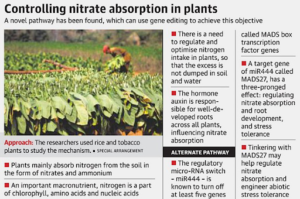In news–A team of researchers from National Centre of Biological Sciences and Tata Institute of Fundamental Research, Bengaluru (NCBS-TIFR) have found a new pathway that regulates nitrate absorption in plants.
A brief note on the new method-
- The researchers studied the gene MADS27, which regulates nitrate absorption, root development and stress tolerance, is activated by the micro-RNA, miR444, therefore offers a way to control these properties of the plant.
- They studied this mechanism in both rice (monocot) and tobacco (dicot) plants.
- The micro-RNA ‘miR444’ is specific to monocots. When this is not made, its target, MADS27, is produced in higher abundance, and it improves biosynthesis and transport of the hormone auxin, which is key for root development and its branching .
- This regulatory miR444 switch is known to turn off at least five genes called MADS box transcription factor genes.
- The speciality of the MADS box transcription factors is that they function like switch boxes of their own. They bind to their favourite specific DNA sequences and they switch the neighbouring genes “on.”

About Nitrogen-
- It is one of the most important macronutrients needed for development of a plant.
- It is a part of chlorophyll, amino acids and nucleic acids, among others.
- It is mostly sourced from the soil where it is mainly absorbed in the form of nitrates and ammonium by the roots.
- Nitrates also play a role in controlling genome-wide gene expression that in turn regulates root system architecture, flowering time, leaf development, etc.
- Thus, while a lot of action takes place in the roots to absorb and convert nitrogen into useful nitrates, the absorbed nitrates in turn regulate plant development apart from being useful as a macronutrient.
- However, the overuse of nitrates in fertilizers, for instance, can lead to the dumping of nitrates in the soil which leads to accumulation of nitrates in water and soil.
















